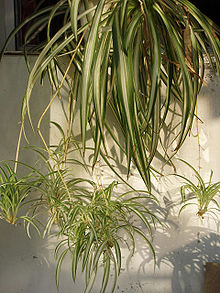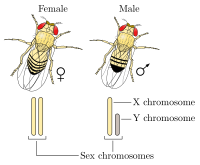Sex


Sex is a type of reproduction common among living things. Sex is used by plants and animals, and also by fungi and various single-celled organisms. It usually needs two individuals which are different sexes from the same species. It works by combining genes from more than one source.[1]
Biological type[change | change source]
Organisms may have more than one kind of reproduction:
- Asexual reproduction: an example is the binary fission of an amoeba. Sometimes jellyfish, and many insects split or produce eggs without fertilisation. These are all methods of asexual reproduction.
- Sexual reproduction: most plants and animals reproduce by a union of two different sexes. Each sex makes the special cells used for reproduction. The new organism is made when both types of cells are united in a fertilised egg or zygote. Organisms that can make both kinds of cells for reproduction are called hermaphrodites. For example, most snails are hermaphrodite.[2]
- Some animals and plants are capable of reproducing either sexually or asexually.
Benefits and drawbacks[change | change source]
Asexual reproduction is easier than sexual reproduction, but there are benefits and drawbacks to both:
- An offspring produced asexually inherits genes only from its parent.
- Offspring produced sexually are genetically somewhat different from either parent. They inherit genes from both parents.
Humans[change | change source]

In humans, sex is normally either male or female. For example: John's sex is male. Jane's sex is female. Most of the time, the sex of a person depends on what sex chromosomes that person got from his or her parents. A woman's ovum (egg cell) contains one X chromosome. A man's sperm contains either an X or a Y chromosome. When a sperm and ova combine to form a fertilised egg, the baby may get either of these chromosomes from its father. If the baby gets two X chromosomes, it will develop into a female. If the baby gets one X and one Y, it will develop into a male. Before babies are born, their sex parts are already formed, but not ready yet. During Puberty, the sex parts finish developing as well as other parts of the body like breasts and body hair.
There are some exceptions to this rule. Sometimes, the process of meiosis, which makes the sex cells, can go differently. This can result in a person having 3 X chromosomes, or 2 Y chromosomes or XXY instead of XY. Other times, the body may not follow exactly what their chromosomes are telling it to do.
Evolution[change | change source]
Sexual reproduction first appeared about a billion years ago. It evolved within single-celled eukaryotes.[3] The scientific community still discusses why it appeared, and why it still exists. Reasons commonly given include:
- Sex creates variation in offspring. If there are traits that give an advantage to the organism, they spread more easily. Traits that give a disadvantage tend to be removed quickly.
Sexual reproduction is a process that can only be found in eukaryotes. These cells have a nucleus and mitochondria. There are other kinds of organisms (other than animals, plants and fungi), the other eukaryotes – such as the malaria parasite – that also engage in sexual reproduction. Some bacteria use conjugation to transfer genetic material between bacteria. This is not the same as sexual reproduction, but it results in a similar mixture of genetic traits.
In sexual reproduction the cells used for reproduction, called gametes, are either eggs or sperms. Fertilisation needs two different such cells. The mechanism of cell division only works when one sperm alone enters the egg. Once it is in, a fast reaction goes through the egg cell wall to shut off all other sperm.[4][5][6]
Sex determination[change | change source]
Sex determination in biology is about the function of sex, not what individuals look like. In humans, males and females usually look different. In many species they do not, except for the sex organs. Sex can be determined in different ways:
- Hermaphrodites produce both male and female gametes. This system can be found in some animals, for example snails, and in most flowering plants.[7]
- In most cases there are separate sexes. This means that an organism either produces male gametes or eggs, but not both at the same time. The biological cause for an organism developing into one sex or the other is called sex determination.
- As a result of sex determination, the organism is either male, or female.
When there is sex determination there are basically two cases:
- The sex is determined through the genes the organism inherits from its parents.
- The sex is determined through the environment.
Genetic[change | change source]

Usually, sex is determined by an organism's genes. With genetic sex determination, most alleles or genes that influence sexual development are on the same chromosome. That chromosome is then called the sex chromosome. Because genetic sex determination is controlled by a pair of sex chromosomes (or if of one of the chromosomes is there or not), there are usually the same number of male and female offspring. In humans, for instance, sperms carry either an X or a Y chromosome, and they occur in roughly equal numbers.

Nongenetic[change | change source]
For some species sex is not determined by inheritance, but instead by environmental factors experienced during development or later in life. Many reptiles have temperature-dependent sex determination: the temperature embryos experience during their development determines the sex of the organism. In some turtles, for example, males are produced at lower incubation temperatures than females; this difference in critical temperatures can be as little as 1-2 °C.
Some fish change sex over the course of their life. This phenomenon is called sequential hermaphroditism.[8] In clownfish, smaller fish are male, and the dominant and largest fish in a group becomes female. In many wrasse the opposite is true—most fish are female at birth and become male when they reach a certain size. Sequential hermaphrodites may produce both types of gametes over the course of their lifetime, but at any given point they are either female or male.
In some ferns the default sex is hermaphrodite. Ferns which grow in soil which has previously supported hermaphrodites are influenced by hormones remaining to develop as male.[9]
Related pages[change | change source]
References[change | change source]
- ↑ King R.C. Stansfield W.D. & Mulligan P.K. 2006. A dictionary of genetics, 7th ed. Oxford.
- ↑ "Common snail, garden snail". BBC. Archived from the original on 2012-12-23. Retrieved 2010-05-13.
- ↑ "Book Review for Life: a natural history of the first Four billion years of life on Earth". Jupiter Scientific. Retrieved 2008-04-07.
- ↑ Amanda Schaffer, "Pas de Deux: why are there only two sexes?", Slate, updated 2007-09-27.
- ↑ Laurence D. Hurst, "Why are there only two sexes?", Proceedings: Biological Sciences, 263 (1996): 415-422.
- ↑ ES Haag, "Why two sexes? Sex determination in multicellular organisms and protistan mating types", Seminars in Cell and Developmental Biology, 18 (2007): 348-9.
- ↑ Dellaporta SL, Calderon-Urrea A (1993). "Sex Determination in Flowering Plants". The Plant Cell. 5 (10): 1241–1251. doi:10.2307/3869777. JSTOR 3869777. PMC 160357. PMID 8281039.
- ↑ Phliip L. Munday; et al. (February 2006). "Diversity and flexibility of sex change strategies in animals" (PDF). Trends in Ecology and Evolution. 21 (1).
- ↑ Tanurdzic M and Banks JA (2004). "Sex-determining mechanisms in land plants". The Plant Cell. 16 (Suppl): S61–S71. doi:10.1105/tpc.016667. PMC 2643385. PMID 15084718.
